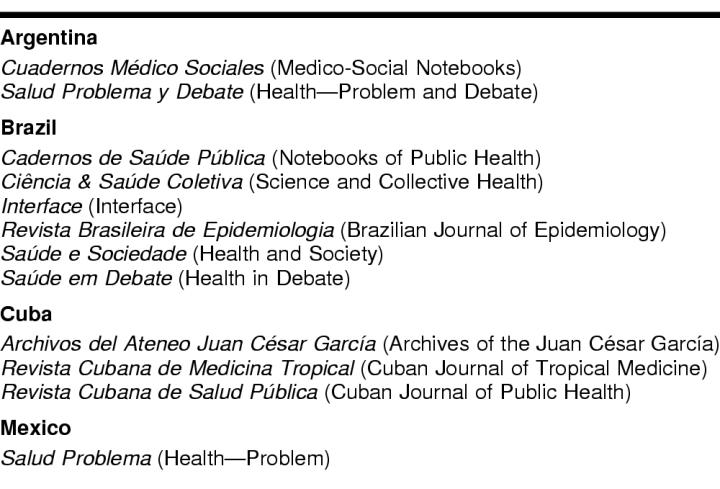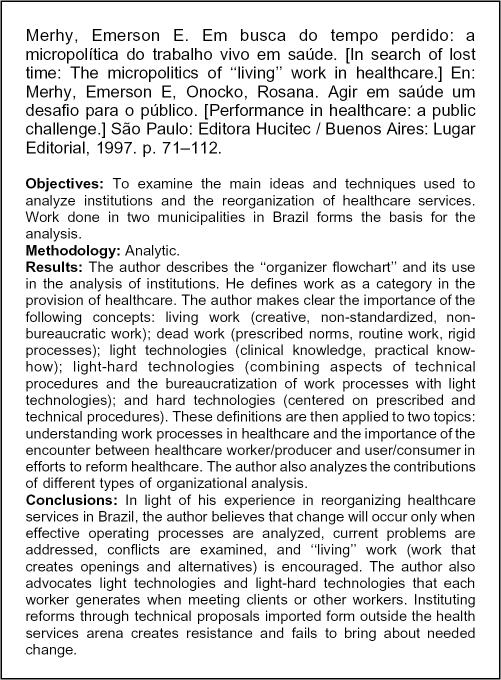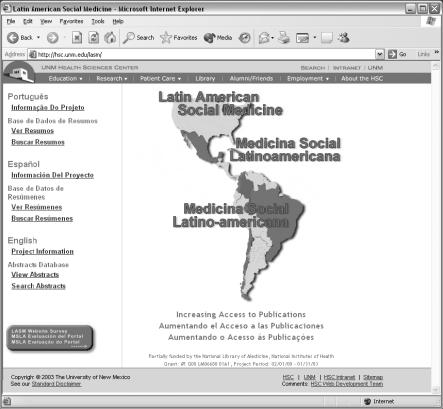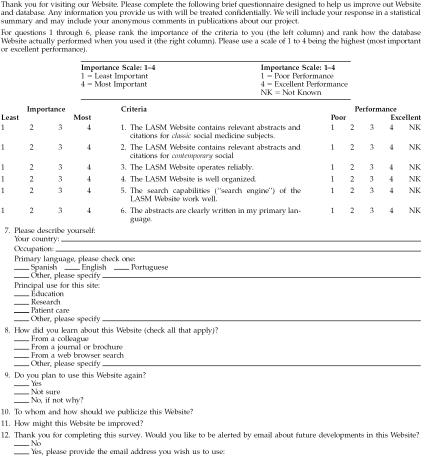Abstract
Purpose: This preliminary report describes the development and implementation of a project to improve access to literature in Latin American social medicine (LASM).
Methods: The University of New Mexico project team collaborated with participants from Argentina, Brazil, Chile, and Ecuador to identify approximately 400 articles and books in Latin American social medicine. Structured abstracts were prepared, translated into English, Spanish, and Portuguese, assigned Medical Subject Headings (MeSH), and loaded into a Web-based database for public searching. The project has initiated Web-based publication for two LASM journals. Evaluation included measures of use and content.
Results: The LASM Website (http://hsc.unm.edu/lasm) and database create access to formerly little-known literature that addresses problems relevant to current medicine and public health. This Website offers a unique resource for researchers, practitioners, and teachers who seek to understand the links between socioeconomic conditions and health. The project provides a model for collaboration between librarians and health care providers. Challenges included procurement of primary material; preparation of concise abstracts; working with trilingual translations of abstracts, metadata, and indexing; and the work processes of the multidisciplinary team.
Conclusions: The literature of Latin American social medicine has become more readily available to researchers worldwide. The LASM project serves as a collaborative model for the creation of sustainable solutions for disseminating information that is difficult to access through traditional methods.
Latin American studies and health care research are two major initiatives of the University of New Mexico (UNM). The authors' report how a multidisciplinary team, which included UNM librarians, came together to create sustainable solutions to increase worldwide access to research that intersects these two initiatives. This article is a preliminary report of a three-year project to develop and implement an Internet-based information system (http://hsc.unm.edu/lasm) to maximize access to Latin American social medicine literature and to facilitate continuing publication and distribution efforts in this field.
BACKGROUND
Social medicine is the diverse field that studies the relationships between society (and its socioeconomic conditions) and the health of populations. Social medicine in Latin America emerged from scientific investigations by early European researchers in the late nineteenth and early twentieth centuries, such as Rudolf Virchow, and the belief systems of indigenous cultures, both of which link social conditions with patterns of illness and death. Followers of Virchow immigrating to Latin American countries at the end of the twentieth century helped to establish Latin American medical schools and included social medicine courses in the curriculum. Today, the International Association of Health Policy and the Asociación Latinoamericana de Medicina Social (ALAMES, Latin American Association of Social Medicine) maintain European–Latin American communication channels through close working relationships. However, Waitzkin, Iriart, Estrada, and Lamadrid observe that while social medicine has become a widely respected and influential field of research, teaching, and clinical practice in Latin America, its advances remain little known in the English-language world [1]. Important publications are currently not translated into English, and the development of this field has been limited by technical difficulties with publishing and distributing scientific communication within Latin America.
To examine the problems of accessibility, our team conducted MEDLINE searches (1990–1998) on two pertinent topics: environmental factors affecting the eradication of endemic infections and the relationship between social violence and primary care utilization. These searches revealed extensive literature in these areas but no citations to the key journals published in Latin American social medicine. The first search on endemic infections yielded 100 citations in the following languages: English (64%), Spanish (26%), Portuguese (9%), and various other languages (1%). First authors of English language publications were affiliated with institutions in the United States (40%); several Latin American countries (Argentina, Brazil, Chile, Colombia, Costa Rica, and Mexico, 45%); and other countries (15%). From the second search on social violence, we identified 71 citations in the following languages: English (57%), Spanish (25%), Portuguese (10%), and other languages (8%). Institutions represented by the first authors of English publications were in the U.S. (40%), Latin America (28%), Scandinavia (7%), and other countries (25%). None of the key institutions with work groups in Latin American social medicine appeared in this search.
The results of the MEDLINE searches indicated that some articles on the key topics or issues in Latin American social medicine are published in English-language journals from U.S. institutions. However, the majority of researchers from Latin America do not publish in English, and the journals they publish in are not indexed for MEDLINE. Thus, the work of the foremost Latin American social medicine researchers and institutions cannot be retrieved using MEDLINE, the recognized standard database for medicine.
Latin American medical and public health literature is indexed in Literatura Latinoamericana y del Caribe en Ciencias de Salud (LILACS, Latin American and Caribbean Literature in Health Sciences), an Internet-accessible database maintained by the Latin American regional library of medicine in Brazil, La Biblioteca Regional de Medicina (BIREME, Regional Library of Medicine). While the LILACS database, supported by the Pan American Health Organization (PAHO), has improved access to the Latin American biomedical literature, the LASM project team found several limitations in the database. As an example, the database did not provide translations of Spanish or Portuguese abstracts into English; did not include an abstract unless it appeared in the original publication; and covered only about half of the key social medicine journals.
PROJECT
To address these challenges of language and distribution, a multidisciplinary team at the UNM Health Sciences Center (HSC) was awarded a three-year grant by the National Library of Medicine of the National Institutes of Health† to develop and implement an Internet-based information system that will maximize access to Latin American social medicine literature and facilitate continuing publication and distribution efforts in this field. The investigators recognized that this work provided an opportunity to digitize information and to offer a platform from which Latin American medical groups eventually could transition to electronic publishing.
For the Latin American Social Medicine project (LASM), partners include faculty in the UNM School of Medicine; UNM Health Sciences Library and Informatics Center (HSLIC); UNM General Library; the Institute of Studies about State and Participation (Argentina); Cândido Ferreira Health Care Service (Brazil); the Investigation and Training Group in Social Medicine, GICAMS (Chile); and the Health and Research Advisory Center (Ecuador).
RATIONALE
The LASM project has been undertaken by the UNM investigators for several key reasons. First, Howard Waitzkin, the principal investigator for the project and a faculty member in the UNM School of Medicine's Department of Family and Community Medicine, has had a long-term interest in research and service concerning U.S. and Latin American public health policy [2–7]. This project builds upon his earlier research in Chile, which was funded by the Fulbright Program and by the Fogarty International Center of the National Institutes of Health‡. That effort used qualitative research methodology to examine the major theoretical approaches and methodological techniques of Latin American social medicine and the field's impact on research, medical practice, and public health.
Second, UNM has an institutional priority to serve as a “University for the Americas” that encourages collaborative projects with universities and government research centers in Latin America. UNM demonstrates this commitment primarily through its Latin American and Iberian Institute (LAII), a federally funded National Resource Center for Foreign Language and Area Studies. LAII administers UNM's interdisciplinary programs in Latin American studies and provides support for a wide spectrum of Latin American and Iberian initiatives in all of UNM's eleven schools and colleges. One major program under LAII is the Ibero-American Science and Technology Education Consortium (ISTEC). ISTEC participants encourage the free flow of and access to information to accomplish the consortium objectives: to “conceive, plan, and carry out activities of higher education, research and development, and technology transfer, for the purpose of facilitating scientific and technical progress of the Ibero-American countries.” Another UNM program, housed in the UNM Physics Department, is the Consortium of the Americas for Interdisciplinary Science, which involves collaboration with Latin American partners.
The third motivating factor is that the UNM Health Sciences Library and Informatics Center has already undertaken similar projects to serve the health information needs of special populations. LASM builds upon the experiences gained in developing national databases to index and abstract Native American resources on health [8]. Also, HSLIC is one of only two academic libraries in the U.S. that attempts to collect materials in the field of Latin American social medicine. The other is the Nettie Lee Benson Latin American Collection of the General Libraries at the University of Texas at Austin.
OBJECTIVES
The LASM project has three objectives. First, the team plans to develop and implement an Internet-accessible database of structured abstracts to access previously published seminal journal articles and books in Latin American social medicine and to make the abstracts available in English, Spanish, and Portuguese. Second, the team will develop and pilot an ongoing process for Web-based publishing of two Latin American social medicine journals in the original languages, accompanied by structured abstracts in English, Spanish, and Portuguese. Third, the team will develop and implement a repository for key journals and books for physical or electronic access by researchers working in the same three languages. This article details the first of these three objectives, development of a database of structured abstracts.
SELECTION
To guide development of the project, the authors established a Peer Selection Committee (PSC) comprised of experts in social medicine from seven Latin American countries and key U.S. institutions. The PSC also includes representatives from the American Medical Association, American Public Health Association, Latin American Studies Association, and the National Library of Medicine. To facilitate communication with members of the PSC and other project partners, the investigators have held formal Internet-based conferences at least twice annually. Project team members have used collaborative, text-based Internet conferencing procedures with concurrent email sessions as well as NetMeeting (free Microsoft Windows software).
The PSC members collaborate with the UNM researchers in identifying books and journals that would be the most appropriate sources of publications to be summarized by the project. Monographs and journals reviewed favorably by the PSC are then ordered for the HSLIC collection. Initially, the PSC members identified fourteen journals as potential sources of literature on Latin American social medicine. Twelve titles were subsequently selected for subscription, indexing, abstracting, and translating (See Table 1). These 12 included 2 from Argentina, 7 from Brazil, 2 from Cuba, and 1 from Mexico [9]. We anticipate that by the end of 2003 the database will include approximately 400 abstracts of both classic and contemporary sources.
Table 1 Journal subscriptions monitored for noteworthy articles on social medicine
ABSTRACTS
To summarize articles, book chapters, and monographs selected for inclusion in the database, the UNM Team developed a format appropriate for both the social sciences and medicine. This format was based on an empirically proven technique for establishing a quick assessment of the relevance and validity of the summarized publications: the structured abstract. Structured abstracts were first proposed in 1987 by the Ad Hoc Working Group for Critical Appraisal of the Medical Literature as a means to “assist clinical readers to select appropriate articles more quickly, allow more precise computerized literature searches, and facilitate peer review before publication” [10]. Over the past decade, leading U.S. health sciences journals, such as JAMA and The New England Journal of Medicine as well as the Journal of the Medical Library Association, have adopted the structured abstract format for original research articles. Various researchers have documented the value of structured abstract to readers as well as to indexing/retrieval processes [11–14].
The literature of Latin American social medicine crosses disciplinary boundaries and includes the behavioral and social sciences, where one finds far fewer examples of the structured abstract format. Work conducted in the United Kingdom, however, has demonstrated the superior readability and desirability of structured abstracts for summarizing articles in the social and behavior sciences [15–19]. An article in Social Science Quarterly by Rudel and Gerson provided a model for this project [20]. Based on a report from Booth and O'Rouke [21] that structured abstracts improve the precision in retrieving relevant articles from databases, the authors project that the inclusion of this type of abstract will enhance search retrieval from the Latin American social medicine database. Figure 1 provides an example of a structured abstract prepared for the LASM database.
Figure 1.
Example of structured abstract
DATABASE
The project database was created using Microsoft SQLServer to establish a Web-accessible repository of the multi-language structured abstracts and citations of the literature. ColdFusion (Allaire Corporation) is an integrated set of visual tools for programming Web-based applications using a tag-based scripting language that integrates with HTML for user interfaces and can be extended to produce XML for data exchange. ColdFusion was used to develop a front-end interface used to query the database. A database-driven structure for the LASM Website was constructed to handle browsing and searching of abstracts. A browsing interface was created and translated into English, Spanish, and Portuguese. A multilingual search engine was also developed to allow users to search the abstract database by information field, MeSH (Medical Subject Headings of the National Library of Medicine) keywords, and full text.
José-Marie Griffiths suggests that the Web is a “bewitching attraction” because it “makes rare resources available anywhere” [22]. However, Griffiths also believes that these very benefits are compromised because information is not comprehensive, there are no standards or validation, and little cataloging occurs. Often, only minimal structure or organization is apparent, and effective retrieval is limited. Our multi-institutional collaborative project shows how the use of the Internet can improve access rather than continue to create the barriers to access described by Griffiths.
As a response to the obstacles Griffiths identified, and to enhance access, the team revised the work plan during the first year of the project to add Dublin Core metadata abstracts in all three languages. A multilingual Dublin Core database was constructed according to standards for metadata access and retrieval, and HSLIC staff intended that the database would be extended as an Open Archives Initiative (OAI) repository for resource discovery. While the addition of metadata was successful, with the trilingual data-entry requirements, the staff resources necessary to undertake this exploration were greater than anticipated. Therefore, the addition of metadata has been currently suspended and will be added at a later date. Figures 2 and 3 present sample materials from the project Website, which is located at http://hsc.unm.edu/lasm/.
Figure 2.
Home page of LASM Website, http://hsc.unm.edu/lasm/
Figure 3.
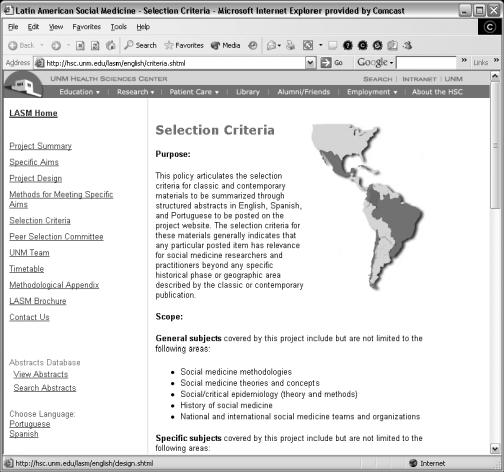
Sample of LASM Website
PROJECT EVALUATION
As an important component of the project, evaluation takes place at several stages and incorporates various methods. In addition, the authors recognize that sustainability of the project after the initial grant-funding period is vital and continue to explore various alternatives to assure this. Griffin has stated that the funding and development of digital libraries will be affected by the “demand for high quality content and ease of access and use” [23]. Therefore, project evaluation includes measures of content and use. WebTrends Log Analyzer, an online application from NetIQ Corporation, measures usage. During 16 months of use since January 2002, almost 11,000 users from 20 different countries have visited the site (excluding spiders and users from UNM). Use of the LASM Website and database can be compared to use of other Web-based HSC resources. An online (or Web) user form (appendix) solicits user feedback, and pre- and post-surveys of potential and actual audiences for the project's products are used to measure and analyze aspects of services that users find most valuable. The questionnaire on value was developed using Parasuraman, Zeithaml, and Berry's determinates of service quality as a guide [24]. In addition, results from analysis of frequently used journal titles or subjects will be provided to the National Library of Medicine's Literature Selection Technical Review Committee for their use in collection development and changes in controlled vocabulary for MEDLINE.
PRELIMINARY LESSONS LEARNED
The authors believe the project will lead to several significant outcomes. It will create access to medical literature that addresses problems relevant to current medicine, public health, and health care delivery, literature that is mostly unknown in the United States. The project will expand the knowledgebase of the mechanics and efficacy of structured abstracts as a means for accessing pertinent medical literature. These efforts will provide models for collaboration between librarians and health care providers and will explore expanded roles for health sciences librarians. In addition, the investigators will communicate lessons learned from these experiences, which will provide useful information to others considering similar collaborative projects.
A substantive review of the LASM project will be prepared at the end of the initial three-year project. However, after two years of working with the project, the investigators have experienced several unexpected challenges that fall into three areas: acquisitions, translation, and abstracting. First, the project team anticipated difficulties procuring publications from Latin American (e.g., delays in receipt of monographs and journal issues). Yet, even with librarians and acquisitions staff experienced with procurement from Latin American countries, the team did not fully anticipate how these problems would affect project work and timelines. Second, trilingual translation (Spanish, Portuguese, and English) of complex concepts in Latin American social medicine required translators with stronger translation skills than first planned and more review and editing by the principal investigator than originally anticipated. The difficulty of creating versions in three languages along with metadata versions of each abstract substantially expanded the scope of the project: one item added to the database essentially yielded six versions of an abstract. Third, preparation of concise abstracts has proved to be more difficult and time consuming than expected. To address these issues, the project team continues to work on adapting the development of structured abstracts to a new literature, improving the efficiency of the translation process, and simplifying the process for entry and revision of abstracts in the database.
In addition, the team has also experienced challenges as a result of its own multidisciplinary composition. During the first year of the project, the team recognized the need to learn the basic concepts and lexicon of other disciplines; to define clearly the roles of team members; to provide appropriate infrastructure to support team members; and to remain patient and tenacious in advancing the project.
In spite of the challenges, several unanticipated benefits have also been identified. For example, the project was a catalyst to exploring the OAI initiative and testing the feasibility of incorporating metadata into the project. In addition, participation in the project has led to increased interest in Latin American libraries. One of the project investigators, Jonathan Eldredge, participated in the Fifth Regional Congress on Health Sciences Information (Congreso Regional de Información en Ciencias de la Salud [CRICS]) sponsored by the World Health Organization and the Pan American Health Organization, held in Havana in April 2001, becoming one of the first U.S. librarians to visit the national library of medicine of Cuba, La Biblioteca Médica Nacional [25].
CONCLUSION
The authors believe that, as a result of this project, the literature of Latin American social medicine will become more readily available to researchers around the world. Recognizing that health sciences libraries in Latin America often lack the resources necessary to solve complex knowledge management issues [26], UNM librarians are building strategies to meet the information needs of researchers. In addition, the team has gained skills in the use of metadata, which can be used with other special knowledge databases and the members have strengthened their skills in operating as a multidisciplinary, collaborative research team. We anticipate that our work will provide a model for the dissemination in multiple languages of crucial information that remains difficult to acquire through traditional methods.
Acknowledgments
The LASM project team wishes to thank Kevin Wiley and Jonathan Tregear for their technical support of the project and Anne Sklar for her work with manuscript preparation.
APPENDIX
LASM User Evaluation Survey
Footnotes
* This manuscript expands on the initial introduction of the project in Buchanan HS, Waitzkin H, Eldredge J, Davidson R, and Iriart C. Digital Information for Latin American Social Medicine: Case Study.” In: Digital Libraries and Virtual Workplaces: Important Initiatives for Latin America in the Information Age, Johann Van Reenen, ed. Washington, DC: Organization for American States, 2002, 179–186.
† Funded by the National Library of Medicine, Grant No. 1G08LM06688-01A1.
‡ Funded by the Fogarty Senior International Fellowship, Fogarty International Center, National Institutes of Health, Grant No. TW01982.
Contributor Information
Holly Shipp Buchanan, Email: hbuchanan@salud.unm.edu.
Howard Waitzkin, Email: hwaitzkin@salud.unm.edu.
Jonathan Eldredge, Email: jeldredge@salud.unm.edu.
Celia Iriart, Email: ciriart@salud.unm.edu.
Janis Teal, Email: jteal@salud.unm.edu.
REFERENCES
- Waitzkin H, Iriart C, Estrada A, and Lamadrid S. Social medicine then and now: lessons from Latin America. Am J Public Health. 2001 Oct; 91(10):1592–1601. [DOI] [PMC free article] [PubMed] [Google Scholar]
- Stocker K, Waitzkin H, and Iriart C. The exportation of managed care to Latin America. N Engl J Med. 1999 Apr 8; 340(14):1131–36. [DOI] [PubMed] [Google Scholar]
- Waitzkin H. The second sickness: contradictions of capitalist health care. Rev. and updated ed. Lanham, MD: Rowman & Littlefield, 2000. [Google Scholar]
- Waitzkin H. At the front lines of medicine: how the health care system alienates doctors and mistreats patients … and what we can do about it. Lanham, MD: Rowman & Littlefield, 2001. [Google Scholar]
- Waitzkin H, Iriart C. How the United States exports managed care to developing countries. Int J Health Serv 2001;31(3):495–505. [DOI] [PubMed] [Google Scholar]
- Iriart C, Merhy EE, and Waitzkin H. Managed care in Latin America: the new common sense in health policy reform. Soc Sci Med. 2001 Apr; 52(8):1243–53. [DOI] [PubMed] [Google Scholar]
- Waitzkin H, Iriart C, Estrada A, and Lamadrid S. Social medicine in Latin America: productivity and dangers facing the major national groups. Lancet. 2001 Jul 28; 358(9278):315–23. [DOI] [PubMed] [Google Scholar]
- Buchanan HS, Morris RC, and Kauley TD. Serving native health needs: merging technology and traditional information services. West J Med. 1999 Nov/Dec; 171(5/6):373–75. [PMC free article] [PubMed] [Google Scholar]
- Davidson R, Waitzkin H, Buchanan HS, Eldredge J, and Iriart C. Latin American Social Medicine—a new source of data and information. LASA Forum. 2002 Fall; 33(3):16–8. [Google Scholar]
- Ad Hoc Working Group for Critical Appraisal of the Medical Literature. A proposal for more informative abstracts of clinical articles. Ann Intern Med. 1987 Apr; 106(4):598–604. [PubMed] [Google Scholar]
- Haynee RB, Mulrow CD, Huth EJ, Altman DG, and Gardner MJ. More informative abstracts revisited. Ann Intern Med. 1990 Jul 1; 113(1):69–76. [DOI] [PubMed] [Google Scholar]
- McIntosh N. Structured abstracts and information transfer. Boston Spa: British Library Research and Development Department, 1994. [Google Scholar]
- Harbourt AM, Knecht LS, and Humphreys BL. Structured abstracts in Medline, 1989–1991. Bull Med Libr Assoc. 1995 Apr; 83(2):190–5. [PMC free article] [PubMed] [Google Scholar]
- Pitkin RM, Branagan MA, and Burmeister LF. Accuracy of data in abstracts of published research articles. JAMA. 1999 Mar 24–31; 281(12):1110–1111. [DOI] [PubMed] [Google Scholar]
- Hartley J. Is it appropriate to use structured abstracts in social science journals? Learned Publishing 1997;10(4):313–17. [Google Scholar]
- Hartley J. Structured abstracts in the British Journal of Clinical Psychology. Br J Clin Psych. 1998 Mar; 37(1):1–2. [Google Scholar]
- Taddio A, Pain T, Fassos FF, Boon H, Ilersich AL, and Einarson TR. Quality of nonstructured and structured abstracts of original research articles in the British Medical Journal, the Canadian Medical Association Journal and the Journal of the American Medical Association. Can Med Assoc J. 1994 May 15; 150(10):1611–5. [PMC free article] [PubMed] [Google Scholar]
- Hartley J, Sydes M, and Blurton A. Obtaining information accurately and quickly: are structured abstracts more efficient? J Info Sci 1996;22(5):349–56. [Google Scholar]
- Hartley J, Sydes M. Are structured abstracts easier to read than traditional ones? J Res Reading 1997;20(2):122–36. [Google Scholar]
- Rudel TK, Gerson JM. Postmodernism, institutional change, and academic workers: a sociology of knowledge. Soc Sci Q. 1999 Sum; 80(2):213–8. [Google Scholar]
- Booth A, O'Rourke A. The value of structured abstracts in information retrieval from MEDLINE. Health Libr Rev. 1997 Sept; 14(3):157–66. [Google Scholar]
- Griffiths JM. Why the web is not a library. In: Hawkins BL, Battin P, eds. The mirage of continuity: reconfiguring academic information resources for the 21st century. Washington, DC: Council on Library and Information Resources and Association of American Universities, 1998. [Google Scholar]
- Griffin SM. NSF/DARPA/NASA digital libraries initiative: a program manager's perspective. In: Harum S, Twidale M, eds. Successes and failures of digital libraries. Champaign, IL: University of Illinois at Urbana–Champaign, 2000. [Google Scholar]
- Parasuraman A, Zeithaml VA, and Berry LL. A conceptual model of service quality and its implications for future research. J Market. 1985 Fall; 49(4):41–50. [Google Scholar]
- Eldredge JD, Piper D, and Hannigan G. La Biblioteca Medica Nacional: The National Medical Library of Cuba. J Med Libr Assoc. 2002 Apr; 90(2):246–8. [PMC free article] [PubMed] [Google Scholar]
- Smith SK. Health libraries in El Salvador. J Hosp Librarianship. 2002 Sum; 2(2):15–24. [Google Scholar]



